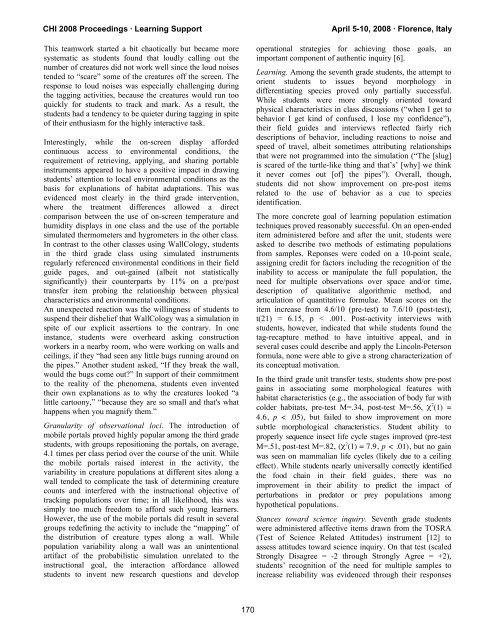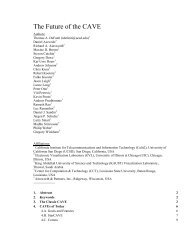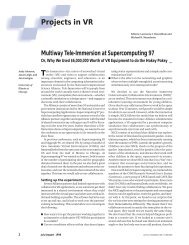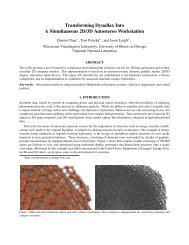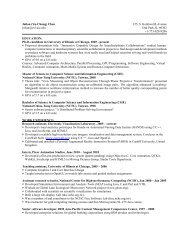pdf (27028 KB) - Electronic Visualization Laboratory - University of ...
pdf (27028 KB) - Electronic Visualization Laboratory - University of ...
pdf (27028 KB) - Electronic Visualization Laboratory - University of ...
You also want an ePaper? Increase the reach of your titles
YUMPU automatically turns print PDFs into web optimized ePapers that Google loves.
CHI 2008 Proceedings · Learning Support April 5-10, 2008 · Florence, Italy<br />
This teamwork started a bit chaotically but became more<br />
systematic as students found that loudly calling out the<br />
number <strong>of</strong> creatures did not work well since the loud noises<br />
tended to “scare” some <strong>of</strong> the creatures <strong>of</strong>f the screen. The<br />
response to loud noises was especially challenging during<br />
the tagging activities, because the creatures would run too<br />
quickly for students to track and mark. As a result, the<br />
students had a tendency to be quieter during tagging in spite<br />
<strong>of</strong> their enthusiasm for the highly interactive task.<br />
Interestingly, while the on-screen display afforded<br />
continuous access to environmental conditions, the<br />
requirement <strong>of</strong> retrieving, applying, and sharing portable<br />
instruments appeared to have a positive impact in drawing<br />
students’ attention to local environmental conditions as the<br />
basis for explanations <strong>of</strong> habitat adaptations. This was<br />
evidenced most clearly in the third grade intervention,<br />
where the treatment differences allowed a direct<br />
comparison between the use <strong>of</strong> on-screen temperature and<br />
humidity displays in one class and the use <strong>of</strong> the portable<br />
simulated thermometers and hygrometers in the other class.<br />
In contrast to the other classes using WallCology, students<br />
in the third grade class using simulated instruments<br />
regularly referenced environmental conditions in their field<br />
guide pages, and out-gained (albeit not statistically<br />
significantly) their counterparts by 11% on a pre/post<br />
transfer item probing the relationship between physical<br />
characteristics and environmental conditions.<br />
An unexpected reaction was the willingness <strong>of</strong> students to<br />
suspend their disbelief that WallCology was a simulation in<br />
spite <strong>of</strong> our explicit assertions to the contrary. In one<br />
instance, students were overheard asking construction<br />
workers in a nearby room, who were working on walls and<br />
ceilings, if they “had seen any little bugs running around on<br />
the pipes.” Another student asked, “If they break the wall,<br />
would the bugs come out?” In support <strong>of</strong> their commitment<br />
to the reality <strong>of</strong> the phenomena, students even invented<br />
their own explanations as to why the creatures looked “a<br />
little cartoony,” “because they are so small and that's what<br />
happens when you magnify them.”<br />
Granularity <strong>of</strong> observational loci. The introduction <strong>of</strong><br />
mobile portals proved highly popular among the third grade<br />
students, with groups repositioning the portals, on average,<br />
4.1 times per class period over the course <strong>of</strong> the unit. While<br />
the mobile portals raised interest in the activity, the<br />
variability in creature populations at different sites along a<br />
wall tended to complicate the task <strong>of</strong> determining creature<br />
counts and interfered with the instructional objective <strong>of</strong><br />
tracking populations over time; in all likelihood, this was<br />
simply too much freedom to afford such young learners.<br />
However, the use <strong>of</strong> the mobile portals did result in several<br />
groups redefining the activity to include the “mapping” <strong>of</strong><br />
the distribution <strong>of</strong> creature types along a wall. While<br />
population variability along a wall was an unintentional<br />
artifact <strong>of</strong> the probabilistic simulation unrelated to the<br />
instructional goal, the interaction affordance allowed<br />
students to invent new research questions and develop<br />
170<br />
operational strategies for achieving those goals, an<br />
important component <strong>of</strong> authentic inquiry [6].<br />
Learning. Among the seventh grade students, the attempt to<br />
orient students to issues beyond morphology in<br />
differentiating species proved only partially successful.<br />
While students were more strongly oriented toward<br />
physical characteristics in class discussions (“when I get to<br />
behavior I get kind <strong>of</strong> confused, I lose my confidence”),<br />
their field guides and interviews reflected fairly rich<br />
descriptions <strong>of</strong> behavior, including reactions to noise and<br />
speed <strong>of</strong> travel, albeit sometimes attributing relationships<br />
that were not programmed into the simulation (“The [slug]<br />
is scared <strong>of</strong> the turtle-like thing and that’s’ [why] we think<br />
it never comes out [<strong>of</strong>] the pipes”). Overall, though,<br />
students did not show improvement on pre-post items<br />
related to the use <strong>of</strong> behavior as a cue to species<br />
identification.<br />
The more concrete goal <strong>of</strong> learning population estimation<br />
techniques proved reasonably successful. On an open-ended<br />
item administered before and after the unit, students were<br />
asked to describe two methods <strong>of</strong> estimating populations<br />
from samples. Reponses were coded on a 10-point scale,<br />
assigning credit for factors including the recognition <strong>of</strong> the<br />
inability to access or manipulate the full population, the<br />
need for multiple observations over space and/or time,<br />
description <strong>of</strong> qualitative algorithmic method, and<br />
articulation <strong>of</strong> quantitative formulae. Mean scores on the<br />
item increase from 4.6/10 (pre-test) to 7.6/10 (post-test),<br />
t(21) = 6.15, p < .001. Post-activity interviews with<br />
students, however, indicated that while students found the<br />
tag-recapture method to have intuitive appeal, and in<br />
several cases could describe and apply the Lincoln-Peterson<br />
formula, none were able to give a strong characterization <strong>of</strong><br />
its conceptual motivation.<br />
In the third grade unit transfer tests, students show pre-post<br />
gains in associating some morphological features with<br />
habitat characteristics (e.g., the association <strong>of</strong> body fur with<br />
colder habitats, pre-test M=.34, post-test M=.56, χ 2 (1) =<br />
4.6, p < .05), but failed to show improvement on more<br />
subtle morphological characteristics. Student ability to<br />
properly sequence insect life cycle stages improved (pre-test<br />
M=.51, post-test M=.82, (χ 2 (1) = 7.9, p < .01), but no gain<br />
was seen on mammalian life cycles (likely due to a ceiling<br />
effect). While students nearly universally correctly identified<br />
the food chain in their field guides, there was no<br />
improvement in their ability to predict the impact <strong>of</strong><br />
perturbations in predator or prey populations among<br />
hypothetical populations.<br />
Stances toward science inquiry. Seventh grade students<br />
were administered affective items drawn from the TOSRA<br />
(Test <strong>of</strong> Science Related Attitudes) instrument [12] to<br />
assess attitudes toward science inquiry. On that test (scaled<br />
Strongly Disagree = -2 through Strongly Agree = +2),<br />
students’ recognition <strong>of</strong> the need for multiple samples to<br />
increase reliability was evidenced through their responses


